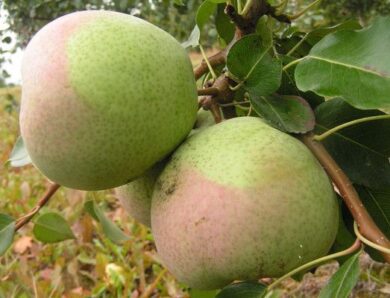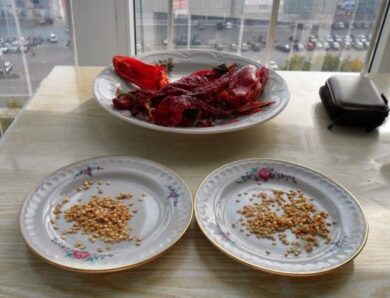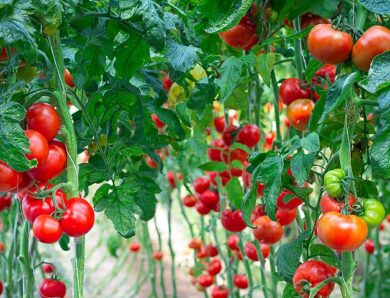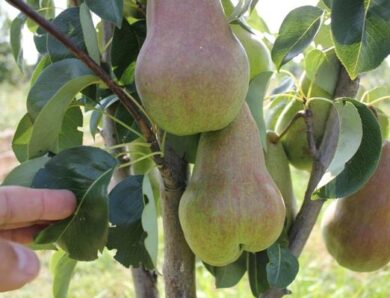Pear varieties for Siberia: description 12 the most frost-resistant
Gardening in the northern regions requires a special approach. First of all, you need to choose the right varieties, resistant to long winters, severe frosts and other climatic conditions. The best varieties of pears for Siberia - in our review.
Isetskaya is juicy
Isetskaya succulent has high winter hardiness, yield and immunity to scabies. Susceptibility to pear gall mites and leaf spot is average. The shape of the crown is almost round.

As the name implies, especially juicy fruits, at the same time sweet, oily. Weight up 110 p. When ripe, they acquire a thick cream color and a blush with a pink tinge, shade sometimes coral. Harvested in the second half of September. Can be stored for about a month.
Sverdlovsk Union
Sverdlovsk Skorospilka is a variety, resistant to severe frosts (to -50 °C) and spring frosts, one of the best for breeding in the Altai. In terms of winter hardiness, it resembles the Flute variety. An important point: Skorospilky grows quite long branches, which is bad for fruiting. It is important for young trees to carry out molding pruning.
The fruits are small, weight 80-110 G, juicy, gentle, very tasty - honey-sweet with harmonious sourness. The smell is pleasant, pronounced. The skin is rough, light yellow, covered with dots.
Lightning
Perun pear is a medium-hardy, therefore, planting is best in southern Siberia. Its important characteristic is resistance to fungal infections (scab, etc.. d.).
Because the variety is self-fertile, Growing this pear in Siberia requires pollinators.
Hilly fruits, large, from 135 to 180 m, golden. Have a sweet and sour taste pleasant. Ripening is late autumn: harvesting begins in October and lasts until the first frosts. Can be stored until the New Year. In the broken state the pear ripens, buying a special juiciness. The fruits are eaten fresh and dried.
In light snow areas, it is desirable to plant such a pear in the spring, otherwise the seedlings may freeze. The first harvest she gives through 4-5 years after planting.
Pink barrel
Pink barrel has a medium level of winter hardiness. The warmer the summer, the earlier the crop ripens (September-November). The description of the fruit corresponds to the name of the variety: a pronounced dark pink blush is clearly visible on the yellow-green skin. The fruits have a pleasant sweet and sour taste.
Svarog
Listing the best varieties for the northern regions, one cannot fail to mention the Svarog pear. The variety has high winter hardiness and good resistance to fungal diseases. To grow a tree, regular watering is required - drought resistance is low. May be affected by pear fruit eater. Yield to 20 kg of wood.
Fruits are small - up to 80 G, yellow with a slight blush. The flesh is creamy, tender, sweet with a pleasant sourness. Harvest begins in mid-September. In the cool it is stored until 3 months. Fruits of universal purpose - they can be eaten fresh and processed.
Lel
The variety is regionalized for the eastern and western Siberian regions. Average winter hardiness. Harvest annually, about 45 kg of wood. Prefers loams.
Fruits from 65 to 100 G, yellow-green with a pronounced blush. Ripen in late August. Choosing this variety, take into account, that the fruits are stored for a very short time, just up to a week in the cool and 2-3 days at room temperature. However, their juiciness, tenderness and wonderful taste (sweet and sour, a little spicy) makes this variety very popular.
Welder
One of the oldest varieties, grown in Siberia. Despite the relatively low yield, it is popular due to its reliability: able to withstand severe frosts (up to -50 °C), adapts to mountain climates. Recovers quickly after troubled winters.
This is a columnar pear, it is quite compact and suitable for small areas. Fruiting begins already on 2 year after landing. Fruit weight - up to 100 m, they are dense, juicy, sweet and sour. The harvest ripens in August. It is recommended to remove it a week before full maturity, as the fruits tend to crumble. They ripen well in the broken state.
Has partial self-fertility (to 35%), pollinators are needed to obtain the crop. Requires abundant watering.
Тайгова
Winter-hardy high-yielding variety. Kidneys and wood are resistant to cold. Excellent immunity to gall mites and scabies. Approximately the same indicators of endurance has a popular pear variety Berezhenaya. Fruiting begins on 4 year. Most often the harvest is reached in late summer.
The fruits are small (to 90 m), but delicious, sweet, desserts, with oily white flesh. Ripe fruits are evenly green. Almost do not fall from the branches, even in strong winds. Used fresh, and also used for conservation, cooking, preparation of compotes and juices. Stored for about a month.
Lukashivka
Frost resistant and high yielding variety: in some years one tree brings to 200 kg of fruit, however bears fruit in a year. Infertile, pollinators are required. Unpretentious to the soil. Tree height up to 5 m. Do not like excess moisture.
The fruits have different shapes - from almost cubic to elongated. Weight - 100-200 p. They are used almost exclusively for conservation: fresh pears are tart and sour, however lying down, they do not ripen, and spoil quickly. But they make good compotes, jam and marmalade. Long-lasting as dried fruit.
Dekabrinka
Winter hardy variety, immune to scabies and pear mite. Drought resistance is average. Yields are high.
The height of the tree can reach 5 m. Non-fertile variety, requires pollinators. Larinsky and Uralochka will be suitable. As in the pear Altai beauty fruiting begins late - through 7 years after planting.
The harvest reaches closer to the end of September. Fruits weigh up 120 G, have a light aroma and white juicy flesh with a sweet and sour taste. Gourmets appreciate them as well, as well as fruits of a pear Berezhenaya. Can be stored from 1 to 3 months, transportable. It is desirable to eat them fresh.
Autumn dream
The variety has a high yield, immunity to scabies and pests. The plant is low, compact. Harvested in late August - early September.
The fruits are small. At the time of ripening green-yellow, after storage the color becomes more saturated. The flesh is sweet and sour, fresh, medium density. The best recycling, rather than fresh consumption. The variety is recommended to choose, who wants to keep the harvest longer: at a temperature of 0 to -1 ° C fruits can be stored for up to six months.
Video "Rules of planting pears"
In this video you will learn about it, how to properly plant a pear in the garden.




